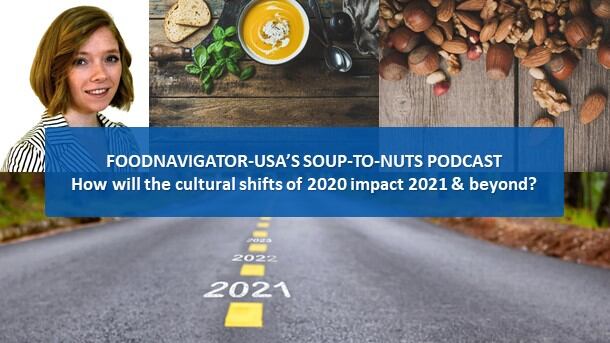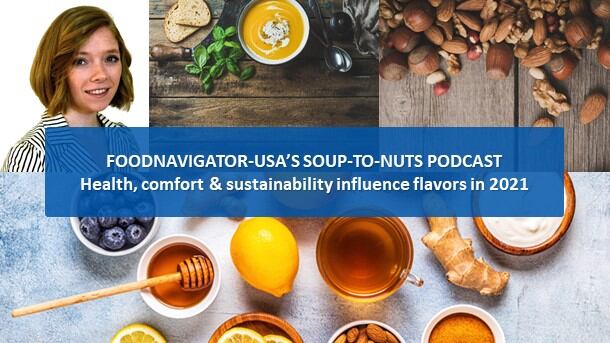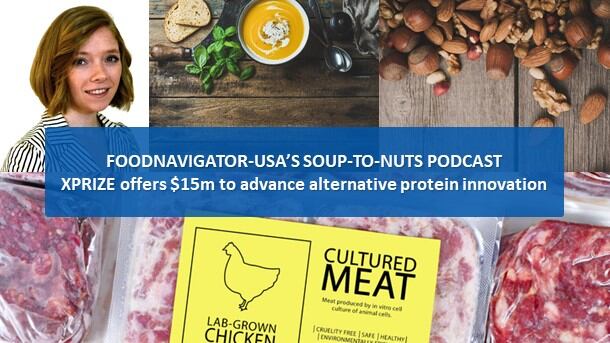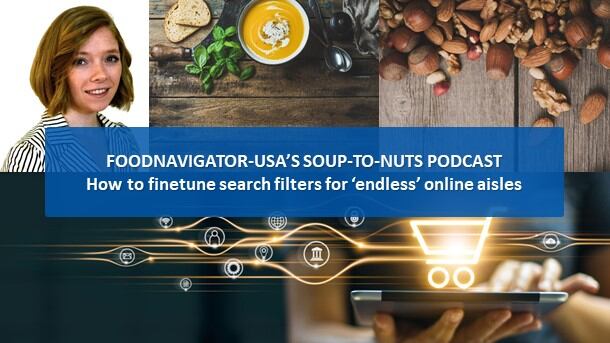According to Emilie Hitch, who is an anthropologist and VP for the full-service agency broadhead, many of the cultural shifts revealed in the chaos of 2020 actually aren’t new – but rather existed sight unseen for years. By remaining hidden, or ignored, these shifts intensified and pulled on our culture, creating a rift between different groups, including consumers and companies. It is now up to businesses to bridge this chasm to reinstate the trust and loyalty on which they rely for long-term growth.
To sort through the tangle of change from 2020 and help companies and individuals chart a path forward, Hitch worked with a team of human-centered design, consumer behavior and creative technology experts at broadhead to create a Culture Shifts content portal. Through this process, Hitch identified nine culture shift predictions that require attention ASAP. In this this episode of FoodNavigator-USA’s Soup-To-Nuts Podcast, Hitch walks us through several of these shifts and their potential impact, including consumers’ expanding definition of health, the need to redesign systems for resilience and preparedness, the brewing war for talent among the modern workforce and role of food in reuniting a country polarized by politics.
[Editor’s Note: Never miss another episode of FoodNavigator-USA’s Soup-To-Nuts podcast – subscribe today!]
Untangling 2020
Broadhead’s Cultural Shifts portal was inspired by the idea that the future is not set in stone, but rather is fluid and therefore no matter how turbulent the present might feel, individuals still have the power to shape the future that they want – but first they need to understand what is happening around them.
“Futures are multiple and potential, and particularly now with the fast pace of business and the fast pace of a lot of global changes" accelerated by the pandemic, Hitch said, adding that broadhead wants to “give counsel or really think through how to respond to those multiple possible futures.”
With that in mind, Hitch recommends that businesses come to the portal with an open mind, rather than a search and address mentality. She says that the portal will help them explore different cultural shifts and see their potential across categories. And, she says, she hopes it will inspire viewers to think about how each change has played out for them in 2020 and what it might mean for the future.
Consumers’ definition of ‘healthy’ expands beyond their physical bodies
While the entire website is worth exploring, there are a few themes or cultural shifts that deserve special attention as Hitch predicts they could have a significant impact on the food and beverage industry in 2021 and beyond, including consumers’ expanding definition of health beyond just their bodies to include their minds, communities and planet.
“I think the stay-at-home portion of the world we’ve been living in for the last nine months has really turned people into reflective beings, and that idea of health shifted quickly to mental health” and not jus immunity, Hitch said. As quarantine dragged on, people began to think not just about themselves but also their friends, families, acquaintances and people they don’t know – including essential workers in grocery stores, meat packing facilities, factories, farms and elsewhere.
Hitch added the social justice movement also is accelerating this awakening and expanded concern. She explains that this shift will impact how manufacturers source ingredients, make finished products and refine their communication and marketing strategies.
“One of the things that I’m really paying close attention to, and from a purpose of life I’m really excited about, is how elements of equity have entered the food conversation. And they’re coming in different angles,” including from regenerative and indigenous agriculture, the push and pull of modernizing farms and wider cultural conversations around food, she said.
This is elevating consumer demand for traceability and transparency, and will challenge manufacturers to rethink how best to communicate their values to consumers on packs and in marketing, she said.
To figure out which labels or claims to promote on pack or what messaging to highlight in marketing as purchasing priorities shift, Hitch recommends – surprise! – listening to consumers and employees. She adds that brands and retailers also should solicit feedback from “gatekeepers,” like Instacart and other online shopping venues that are placed between them and the consumer.
What companies learn might be that social media or paved advertising is not the most effective way to reach consumers. Rather, Hitch said, they might find that their actions speak louder than words.
“Get as creative as possible in getting off your screens and trying to create engagement or taking action that will translate into messages that your brand loyalists and the people of the world that you want to communicate with will hear,” she said. “So, it might not be spending money on a better website. It might be investing in your supply chain and then telling people why. … It might be changing the way you source things and the communicating to everyone why you’re doing that.”
Building for resilience, preparedness
Hitch’s examples of refining how ingredients are sourced or products are made to align with consumer values also can help companies adapt to another cultural shift that Hitch says she is watching, which is redesigning systems for resilience and preparedness.
“There’s a tension between what CPG companies say and what they do, and that’s an age old marketing conundrum of how much of what we do behind the scenes do we talk about in the public. But now there is this demand for transparency and betterment. People are really hungry for leaders … to show an actual plan, an action,” Hitch said.
She added that while CPG companies can’t control all the systems that they are a part of, they can communicate how they’re going to better those process. These steps don’t need big budgets or to be high-tech – although they could – but rather they just need to be a clear path forward, she added.
An expanded talent pool
As companies redefine their values and behavior, they may also need to rethink their teams to ensure they have the best possible leaders and teams in place. Luckily, Hitch notes, the pandemic has actually made it easier to find top talent.
“The advent of so many people working from home, so many jobs going remote, has really opened up the talent pool, and the way that I think about it is, wherever the best mind is to fit that job you’re hiring for at this point, you don’t have to move them,” Hitch said.
This allows for a different kind of hiring process and the ability to find candidates who are the best cultural and intelligence fit and who bring the right skills to the job, she said.
Food offers a chance for unity
For Hitch, there seems to be a silver lining – and opportunity to learn and improve – from each of the challenges that 2020 through at us, including the highly divisive and polarizing presidential and local elections.
“While we see numbers that show 50%, 51% vote one way and 49% vote another way, we forget that we actually share a lot of values,” and “my hope is we’re entering a cooldown where we really try to find a common ground and where we are not just red, blue or other,” Hitch said.
She adds that food is a great connector and companies should look for ways to bring people together – not just across the supply chain – but at the table to build relationships beyond the industry and help others do the same.
Clearly the food and beverage industry – and US as a whole – has a long road ahead to healing and building back better from the rubble that 2020 has left, but as Hitch notes, the industry has a strong history and foundation of unity and advancement on which to stand and move forward.




